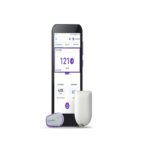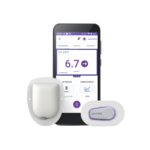OMNIPOD Automated Insulin Delivery System Instructions

INSTRUCTIONS FOR USE
- Download user’s device to My.Glooko.com—> Set report settings to Target Range 3.9-10.0 mmol/L
- Create reports—> 2 weeks —> Select: a. CGM Summary;
b. Week View; and c. Devices - Follow this worksheet for step-by-step guidance on clinical assessment, user education and insulin dose adjustments.
STEP 1 BIG PICTURE (PATTERNS)
—> STEP 2 SMALL PICTURE (REASONS)
—> STEP 3 PLAN (SOLUTIONS)
OVERVIEW using C|A|R|E|S Framework
C | How it CALCULATES
- Automated basal insulin delivery calculated from total daily insulin, which is updated with each Pod change (adaptive basal rate).
- Calculates dose of insulin every 5 min based on glucose levels predicted 60 minutes into future.
A | What you can ADJUST
- Can adjust the algorithm’s Target Glucose (6.1, 6.7, 7.2, 7.8, 8.3 mmol/L) for adaptive basal rate.
- Can adjust I:C ratios, correction factors, active insulin time for bolus settings.
- Cannot change basal rates (programmed basal rates are not used in Automated Mode).
R | When it REVERTS to manual mode
- System may revert to Automated Mode: Limited (static basal rate determined by system; not based on
CGM value/trend) for 2 reasons:
- If CGM stops communicating with Pod for 20 min. Will resume full automation when CGM returns.
- If an Automated Delivery Restriction alarm occurs (insulin delivery suspended or at max delivery too long). Alarm must be cleared by user and enter Manual Mode for 5 min. Can turn Automated Mode back on after 5 minutes.
E | How to EDUCATE
- Bolus before eating, ideally 10-15 minutes prior.
- Tap Use CGM in bolus calculator to add glucose value and trend into bolus calculator.
- Treat mild hypoglycaemia with 5-10g carb to avoid rebound hyperglycaemia and WAIT 15 min before re-treating to give glucose time to rise.
- Infusion site failure: Check ketones and replace Pod if hyperglycaemia persists (e.g. 16.7 mmol/L for > 90 min) despite correction bolus. Give syringe injection for ketones.
S | SENSOR/SHARE characteristics
- Dexcom G6 which requires no calibrations.
- Must use G6 mobile app on smartphone to start CGM sensor (cannot use Dexcom receiver or Omnipod 5 Controller).
- Can use Dexcom Share for remote monitoring of CGM dat
- Focus on behavior: Wearing the CGM consistently, giving all boluses, etc.
- When adjusting insulin pump settings, focus primarily on Target Glucose and I:C ratios.
- To make system more aggressive: Lower the Target Glucose, encourage user to give more boluses and intensify bolus settings (e.g. I:C ratio) to increase total daily insulin (which drives the automation calculation).
- Avoid overthinking the automated basal delivery. Focus on the overall Time in Range (TIR), and optimising system use, bolus behaviors and bolus doses.
If <90%, discuss why:
- Problems accessing supplies/sensors not lasting 10 days?
—>Contact Dexcom for replacement sensors - Skin problems or difficulty keeping sensor on?
—>Rotate sensor insertion sites (arms, hips, buttocks, abdomen)
—>Use barrier products, tackifiers, overtapes and/or adhesive remover to protect skin
If <90%, assess why:
Emphasise goal is to use Automated Mode as much as possible
If >5%, assess why:
- Due to gaps in CGM data?
—>Review device placement: wear Pod and CGM on same side of body / in “line of sight” to optimise Pod-CGM communication - Due to automated delivery restriction (min/max delivery) alarms?
—>Educate user to clear alarm, check BG as needed, and after 5 minutes switch mode back to Automated Mode (will not return to Automated Mode automatically)
Is the user giving at least 3 “Diet Entries/Day” (boluses with CHO added)?
—>If not, ASSESS for missed meal boluses
- The goal of this therapy review is to increase Time in Range (3.9-10.0 mmol/L) while minimising Time Below Range (< 3.9 mmol/L)
- Is the Time Below Range more than 4%? If YES, focus on reducing patterns of hypoglycaemia If NO, focus on reducing patterns of hyperglycaemia

Time in Range (TIR)
3.9-10.0mmol/L “Target Range”
Time Below Range (TBR)
< 3.9 mmol/L “Low” + “Very Low”
>10.0 mmol/L “High” + “Very High”
Ambulatory Glucose Profile compiles all data from reporting period into one day; shows median glucose with the blue line, and variability around the median with the shaded ribbons. Wider ribbon = more glycemic variability.
Hyperglycemia patterns: (eg: high glycemia at bedtime)
———————————————————————-
Hypoglycemia patterns:
———————————————————————
———————————————————————

Is the hypoglycaemia pattern occurring:
- Fasting /Overnight?
- Around mealtime?
(1-3 hours after meals) - Where low glucose levels follow high glucose levels?
- Around or after exercise?
Is the hyperglycaemia pattern occurring:
- Fasting /Overnight?
- Around mealtime? (1-3 hours after meals)
- Where high glucose levels follow low glucose levels?
- After a correction bolus was given? (1-3 hours after co
| Hypoglycemia | Hyperglycemia | |
|
SOLUTION |
PATTERN |
SOLUTION |
| Raise Target Glucose (algorithm target) overnight (highest is 8.3 mmol/L) | Fasting / Overnight |
Lower Target Glucose overnight (lowest is 6.1 mmol/L) |
| Assess carb counting accuracy, bolus timing, and meal composition. Weaken I:C Ratios by 10-20% (e.g. if 1:10g, change to 1:12g | Around mealtime (1-3 hours after meals) |
Assess if meal bolus was missed. If yes, educate to give all meal boluses prior to eating. Assess carb counting accuracy, bolus timing, and meal composition. Strengthen I:C Ratios by 10-20% (e.g. from 1:10g to 1:8g) |
| If due to bolus calculator overrides, educate user to follow the bolus calculator and avoid overriding to give more than recommended. There may be a lot of IOB from AID that user is not aware of. Bolus calculator factors in IOB from increased AID when calculating correction bolus dose. | Where low glucose follows high glucose |
|
| Weaken correction factor by 10-20% (e.g. from 3mmol/L to 3.5 mmol/L) if hypos 2-3 hours after correction bolus. | Where high glucose follows low glucose |
Educate to treat mild hypoglycaemia with fewer grams of carbs (5-10g) |
| Use the Activity feature 1-2 hours before exercise begins. Activity feature will temporarily reduce insulin delivery. It can be used during times of increased risk of hypoglycaemia. To use Activity feature, go to Main Menu —> Activity | Around or after exercise |
|
| After a correction bolus was given (1-3 hours after correction bolus) | Strengthen correction factor (e.g. from 3 mmol/L to 2.5 mmol/L) |
- Target Glucose (for adaptive basal rate) Options: 6.1, 6.7, 7.2, 7.8, 8.3 mmol/L Can program di!erent targets for di!erent times of day
- I:C Ratios It is common to need stronger I:C Ratios with AID
- Correction Factor & Active Insulin Time These will only influence bolus calculator doses; has no impact on automated insulin To change settings, tap the main menu icon in top-left corner of Omnipod 5 controller: —> Settings —> Bolus
BEFORE making changes to insulin delivery settings, please confirm insulin settings within the user’s Omnipod 5 controller.

Great job using Omnipod 5

Using this system may help you achieve your diabetes goals.
The American Diabetes Association suggests aiming for 70% of your glucose levels to be between 3.9–10.0 mmol/L, called Time in Range or TIR. If you are not currently able to reach 70% TIR, don’t be discouraged! Start from where you are and set smaller goals to increase your TIR. Any increase in your TIR is beneficial to your lifelong health!
![]() REMEMBER…
REMEMBER…
Don’t overthink what the Omnipod 5 is doing in the background.
Focus on what you can do. See helpful tips below…
TIPS for Omnipod 5

- HYPERGLYCAEMIA >16.7 mmol/L for 1-2 hours? Check ketones first!
If ketones, give syringe injection of insulin and replace Pod. - Bolus before eating, ideally 10-15 minutes before all meals and snacks.
- Do not override the bolus calculator: Correction bolus doses may be smaller than expected due to insulin on board from the adaptive basal rate.
- Give correction boluses for hyperglycaemia: Tap Use CGM in bolus calculator to add glucose value and trend into bolus calculator.
- Treat mild hypoglycaemia with 5-10g carb to avoid rebound hyperglycaemia and WAIT 15 min before re-treating to give glucose time to rise. System will have likely suspended insulin, resulting in little insulin on board when hypoglycaemia occurs.
- Wear Pod and CGM on same side of body so they don’t lose connection.
- Clear Delivery Restriction alarms immediately, troubleshoot hyper/hypo, confirm CGM accuracy and switch back to Automated Mode.
PANTHERprogram.org
dexcom-intl.custhelp.com
Dexcom customer support
0800 031 5761
Dexcom technical support
0800 031 5763

Documents / Resources
 |
OMNIPOD Automated Insulin Delivery System [pdf] Instructions Automated Insulin Delivery System, Insulin Delivery System, Delivery System, System |





